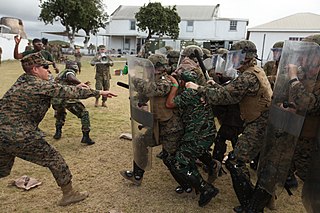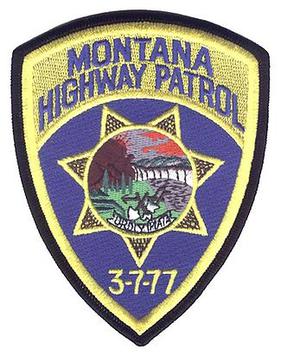Related Research Articles

Non-lethal weapons, also called nonlethal weapons, less-lethal weapons, less-than-lethal weapons, non-deadly weapons, compliance weapons, or pain-inducing weapons are weapons intended to be less likely to kill a living target than conventional weapons such as knives and firearms with live ammunition. It is often understood that unintended or incidental casualties are risked wherever force is applied, however non-lethal weapons minimise the risk of casualties as much as possible. Non-lethal weapons are used in policing and combat situations to limit the escalation of conflict where employment of lethal force is prohibited or undesirable, where rules of engagement require minimum casualties, or where policy restricts the use of conventional force. However, these weapons occasionally cause serious injuries or death due to allergic reactions, improper use and/or other factors; for this reason the term "less-lethal" has been preferred by some organizations as it describes the risks of death more accurately than the term "non-lethal", which some have argued is a misnomer.

A TASER is a conducted energy device (CED) primarily used to incapacitate people, allowing them to be approached and handled in an unresisting and thus less-lethal manner. Sold by Axon, formerly TASER International, the TASER fires two small barbed darts intended to puncture the skin and remain attached to the target until removed by the user of the TASER device, at a speed of 55 m/s. Their range extends from 4.5 m (15 ft) for non-Law Enforcement Tasers to 10.5 m (34 ft) for Law Enforcement Tasers. The darts are connected to the main unit by thin laquer insulated copper wire and deliver a modulated electric current designed to disrupt voluntary control of muscles, causing "neuromuscular incapacitation." The effects of a taser may only be localized pain or strong involuntary long muscle contractions, based on the mode of use and connectivity of the darts.

Riot control measures are used by law enforcement, military, paramilitary or security forces to control, disperse, and arrest people who are involved in a riot, unlawful demonstration or unlawful protest.

An electroshock weapon is an incapacitating weapon. It delivers an electric shock aimed at temporarily disrupting muscle functions and/or inflicting pain, usually without causing significant injury.
The Active Denial System (ADS) is a non-lethal directed-energy weapon developed by the U.S. military, designed for area denial, perimeter security and crowd control. Informally, the weapon is also called the heat ray since it works by heating the surface of targets, such as the skin of targeted human beings. Raytheon had marketed a reduced-range version of this technology. The ADS was deployed in 2010 with the United States military in the Afghanistan War, but was withdrawn without seeing combat. On August 20, 2010, the Los Angeles Sheriff's Department announced its intent to use this technology to control incarcerated people in the Pitchess Detention Center in Los Angeles, stating its intent to use it in "operational evaluation" in situations such as breaking up prisoner fights. As of 2014, the ADS was only a vehicle-mounted weapon, though U.S. Marines and police were both working on portable versions. ADS was developed under the sponsorship of the Department of Defense Non-Lethal Weapons Program with the Air Force Research Laboratory as the lead agency. There are reports that Russia and China are developing their own versions of the Active Denial System.
Stopping power is the ability of a weapon – typically a ranged weapon such as a firearm – to cause a target to be incapacitated or immobilized. Stopping power contrasts with lethality in that it pertains only to a weapon's ability to make the target cease action, regardless of whether or not death ultimately occurs. Which ammunition cartridges have the greatest stopping power is a much-debated topic.

A riot shotgun is a shotgun designed or modified for use as a primarily defensive weapon, by the use of a short barrel and sometimes a larger magazine capacity than shotguns marketed for hunting. The riot shotgun is used by military personnel for guard duty and was at one time used for riot control, and is commonly used as a door breaching and patrol weapon by law enforcement personnel, as well as a home defense weapon by civilians. Guns of this type are often labeled as breaching shotguns, tactical shotguns or special-purpose shotguns to denote the larger scope of their use; however, these are largely marketing terms.
Pain compliance is the use of painful stimulus to control or direct an organism.

The Hamilton Police Service (HPS) is the police service of the city of Hamilton, Ontario, Canada. As of 2021, the service employed 829 sworn officers and 414 non-sworn staff, serving a population of about 570 000 residents. The service's headquarters are located at 155 King William St., Hamilton, Ontario. As of 2022, the service's budget is $183 542 539, roughly 18.5% of the City's overall budget. It is one of the oldest police forces in Ontario.
Axon Enterprise, Inc. is an American company based in Scottsdale, Arizona that develops technology and weapons products for military, law enforcement, and civilians.

A use of force continuum is a standard that provides law enforcement officers and civilians with guidelines as to how much force may be used against a resisting subject in a given situation. In some ways, it is similar to the U.S. military's escalation of force (EOF). The purpose of these models is to clarify, both for law enforcement officers and civilians, the complex subject of use of force. They are often central parts of law enforcement agencies' use of force policies. Various criminal justice agencies have developed different models of the continuum, and there is no universal or standard model. Generally, each different agency will have their own use of force policy. Some agencies may separate some of the hand-to-hand based use of force. For example, take-downs and pressure point techniques may be one step before actual strikes and kicks. Also, for some agencies the use of aerosol pepper spray and electronic control devices (TASER) may fall into the same category as take-downs, or the actual strikes.

The Montana Highway Patrol (MHP) is the highway patrol agency for the U.S. state of Montana, for which it has state wide jurisdiction.
On November 14, 2006, Mostafa Tabatabainejad, a fourth-year University of California, Los Angeles (UCLA) student, was drive stunned five times with a Taser by campus police while handcuffed.
In the United Kingdom police firearm policy varies by constituent countries. In Northern Ireland, all police officers carry firearms whereas in the rest of the United Kingdom, firearms are carried only by specially-trained firearms officers.

Taser safety issues relate to the lethality of the Taser. The TASER device is a less-lethal, not non-lethal, weapon, since the possibility of serious injury or death exists whenever the weapon is deployed. It is a brand of conducted electroshock weapon sold by Axon, formerly TASER International. Axon has identified increased risk in repeated, extended, or continuous exposure to the weapon; the Police Executive Research Forum says that total exposure should not exceed 15 seconds.

On October 14, 2007, Robert Dziekański, a 40-year old Polish immigrant to Canada, was killed during an arrest at the Vancouver International Airport in Richmond, British Columbia (BC).

Bryan v. McPherson, 630 F.3d 805, was heard by United States Court of Appeals for the Ninth Circuit in October 2009. Plaintiff-appellee Carl Bryan was tasered by defendant-appellant Officer Brian MacPherson after being pulled over to the side of the road for failure to wear a seat belt. The case considered whether MacPherson's use of a taser during a routine traffic stop violated Bryan's Fourth Amendment rights. The majority opinion, written by Kim McLane Wardlaw, declared that the use of the taser in this situation could be considered excessive force. Richard Tallman and Consuelo María Callahan wrote the dissent. This case affirmed that this use of a taser could indeed be considered excessive force.
Roberto Laudisio Curti, known as Beto Laudisio, was a 21-year-old man from São Paulo, Brazil. He died on 18 March 2012 after being pursued, tackled, tasered, sprayed with OC spray, and physically compressed under the weight of multiple police officers of the New South Wales Police Force in Sydney, Australia.

Jordan Lee Begley, also known as Jordon Begley, a 23-year-old English man, died of cardiac arrest on 10 July 2013. An inquest in 2015 found that Begley's death had been partly due to the actions of Greater Manchester Police officers who shot him with a Taser while they restrained and handcuffed him around two hours prior to his death.

A laser sight is a device attached or integral to a firearm to aid target acquisition. Unlike optical and iron sights where the user looks through the device to aim at the target, laser sights project a beam onto the target, providing a visual reference point.
References
- ↑ Nystrom, Paul (2012). "The Conducted Electrical Weapon: Historical Overview of the Technology". Atlas of Conducted Electrical Weapon Wounds and Forensic Analysis. pp. 1–23. doi:10.1007/978-1-4614-3543-3_1. ISBN 978-1-4614-3542-6.
- 1 2 3 Panescu, Dorin; Max Nerheim; Mark Kroll (2013). "Electrical safety of conducted electrical weapons relative to requirements of relevant electrical standards". 2013 35th Annual International Conference of the IEEE Engineering in Medicine and Biology Society (EMBC). Vol. 2013. pp. 5342–5347. doi:10.1109/EMBC.2013.6610756. ISBN 978-1-4577-0216-7. PMID 24110943. S2CID 19800784.
- ↑ "TASER X2 Defender". TASER International Inc. Archived from the original on 2013-11-13.
- ↑ White, Michael; Justin Ready (May 2007). "The TASER as a Less Lethal Force Alternative Findings on Use and Effectiveness in a Large Metropolitan Police Agency". Police Quarterly. 10 (2): 170–191. doi: 10.1177/1098611106288915 .
- ↑ Holder, Eric; Laurie O. Robinson; John H. Laub (May 2011). "Police Use of Force, Tasers and Other Less-Lethal Weapons" (PDF).
{{cite journal}}: Cite journal requires|journal=(help)